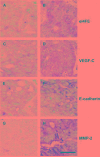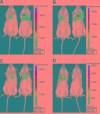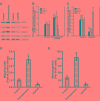Expression analysis and clinical significance of eIF4E, VEGF-C, E-cadherin and MMP-2 in colorectal adenocarcinoma
- PMID: 27907907
- PMCID: PMC5356753
- DOI: 10.18632/oncotarget.13453
Expression analysis and clinical significance of eIF4E, VEGF-C, E-cadherin and MMP-2 in colorectal adenocarcinoma
Abstract
The underlying mechanisms of colorectal carcinoma (CRC) metastasis remain to be elucidated. The aim of this study is to investigate clinical significance and the expression of eIF4E, VEGF-C, MMP-2, and E-cadherin in the CRC metastasis. We investigated their expressions in 108 patients, analyzed the relationships between their expressions in CRC and evaluated the relationships between their expressions and clinical pathogenic parameters. Furthermore, their roles in patient survival and in CRC metastasis were also investigated. We found that eIF4E, VEGF-C and MMP-2 were up-regulated in CRC, and their expression frequencies (EFs) were higher in cancerous tissues than in adjacent normal tissues. The EF of E-cadherin is lower in cancerous tissues than in adjacent normal tissues. Totally, their EFs were not associated with sex and age of patient, however, their EFs were associated with tumor differentiation, the depth of invasion, lymph node metastasis and tumor stages. Furthermore, eIF4E, VEGF-C, and MMP-2 shortened and E-cadherin prolonged survival in patient-derived CRC xenografts. Similarly, eIF4E, VEGF-C, and MMP-2 promoted and E-cadherin suppressed the lung metastasis of CRC cells. In addition, knockdown of eIF4E inhibited migration of CRC cells, downregulated VEGF-C, MMP-2 and upregulated E-cadherin. In conclusion, eIF4E promoted CRC metastasis via up-regulating the expression of VEGF-C, MMP-2 and suppressing E-cadherin.
Keywords: E-cadherin; MMP-2; VEGF-C; colorectal cancer; eIF4E.
Conflict of interest statement
The authors declare no conflicts interest.
Figures






Similar articles
-
Vascular endothelial growth factor C disrupts the endothelial lymphatic barrier to promote colorectal cancer invasion.Gastroenterology. 2015 Jun;148(7):1438-51.e8. doi: 10.1053/j.gastro.2015.03.005. Epub 2015 Mar 6. Gastroenterology. 2015. PMID: 25754161
-
AEG-1 induces gastric cancer metastasis by upregulation of eIF4E expression.J Cell Mol Med. 2017 Dec;21(12):3481-3493. doi: 10.1111/jcmm.13258. Epub 2017 Jun 29. J Cell Mol Med. 2017. PMID: 28661037 Free PMC article.
-
Clinicopathological significance of E-cadherin, VEGF, and MMPs in gastric cancer.Tumour Biol. 2010 Dec;31(6):549-58. doi: 10.1007/s13277-010-0068-y. Epub 2010 Jun 19. Tumour Biol. 2010. PMID: 20563765
-
Effect of E-cadherin on Prognosis of Colorectal Cancer: A Meta-Analysis Update.Mol Diagn Ther. 2022 Jul;26(4):397-409. doi: 10.1007/s40291-022-00593-3. Epub 2022 Jun 22. Mol Diagn Ther. 2022. PMID: 35732878 Review.
-
Targeting Invasion: The Role of MMP-2 and MMP-9 Inhibition in Colorectal Cancer Therapy.Biomolecules. 2024 Dec 30;15(1):35. doi: 10.3390/biom15010035. Biomolecules. 2024. PMID: 39858430 Free PMC article. Review.
Cited by
-
Frequent Intraluminal Growth of Large Muscular Veins in Surgically Resected Colorectal Cancer Tissues: A 3-Dimensional Pathologic Reconstruction Study.Mod Pathol. 2023 Mar;36(3):100082. doi: 10.1016/j.modpat.2022.100082. Epub 2023 Jan 10. Mod Pathol. 2023. PMID: 36788099 Free PMC article.
-
Molecules promoting circulating clusters of cancer cells suggest novel therapeutic targets for treatment of metastatic cancers.Front Immunol. 2023 Mar 15;14:1099921. doi: 10.3389/fimmu.2023.1099921. eCollection 2023. Front Immunol. 2023. PMID: 37006265 Free PMC article. Review.
-
Copy number and transcriptome alterations associated with metastatic lesion response to treatment in colorectal cancer.Clin Transl Med. 2021 Apr;11(4):e401. doi: 10.1002/ctm2.401. Clin Transl Med. 2021. PMID: 33931971 Free PMC article.
-
Oxidized Low-Density Lipoprotein as a Potential Target for Enhancing Immune Checkpoint Inhibitor Therapy in Microsatellite-Stable Colorectal Cancer.Antioxidants (Basel). 2025 Jun 13;14(6):726. doi: 10.3390/antiox14060726. Antioxidants (Basel). 2025. PMID: 40563359 Free PMC article. Review.
-
The Prognostic Value of m6A RNA Methylation Regulators in Colon Adenocarcinoma.Med Sci Monit. 2019 Dec 11;25:9435-9445. doi: 10.12659/MSM.920381. Med Sci Monit. 2019. PMID: 31823961 Free PMC article.
References
-
- American Cancer Association. Cancer Facts & Figures 2016. American Cancer Association.
-
- Sunavala-Dossabhoy G, Palaniyandi S, Clark C, Nathan CO, Abreo FW, Caldito G. Analysis of eIF4E and 4EBP1 mRNAs in head and neck cancer. The Laryngoscope. 2011;121:2136–2141. - PubMed
-
- de Oliveira AT, Reis RM, Afonso J, Martinho O, Matos D, Carvalho AL, Vazquez VL, Silva TB, Scapulatempo C, Saad SS, Longatto-Filho A. Lymphangiogenic VEGF-C and VEGFR-3 expression in genetically characterised gastrointestinal stromal tumours. Histology and histopathology. 2011;26:1499–1507. - PubMed
-
- Beavon IR. The E-cadherin-catenin complex in tumour metastasis: structure, function and regulation. European journal of cancer. 2000;36:1607–1620. - PubMed
MeSH terms
Substances
LinkOut - more resources
Full Text Sources
Other Literature Sources
Medical
Miscellaneous

